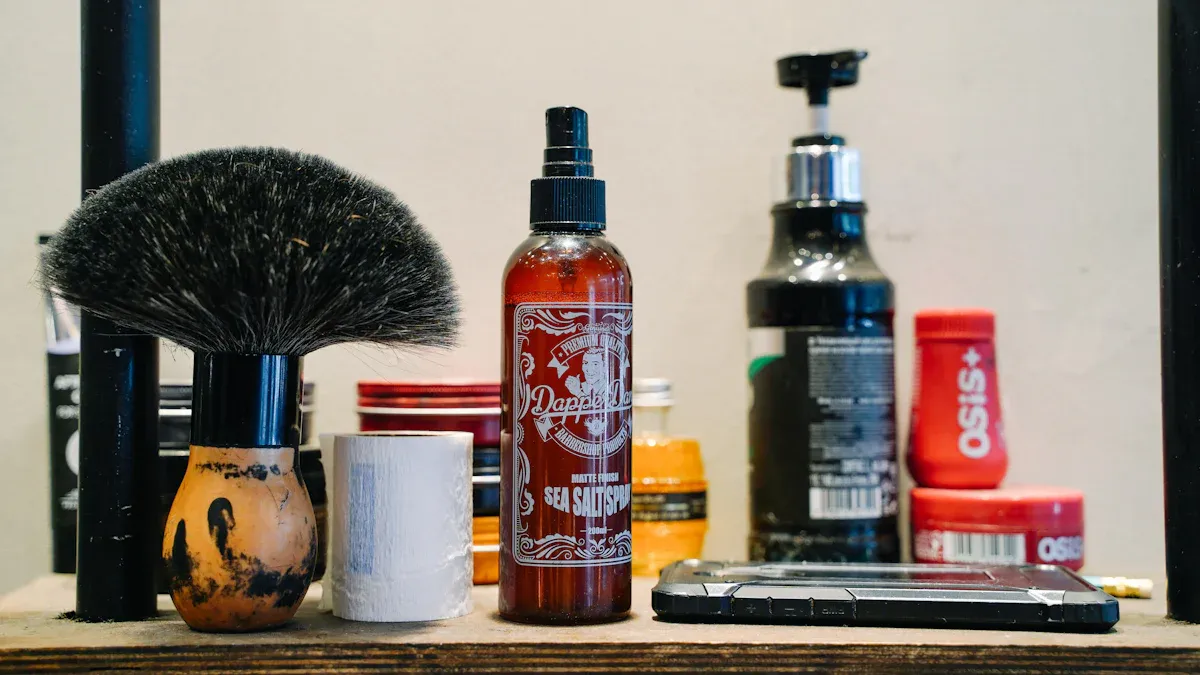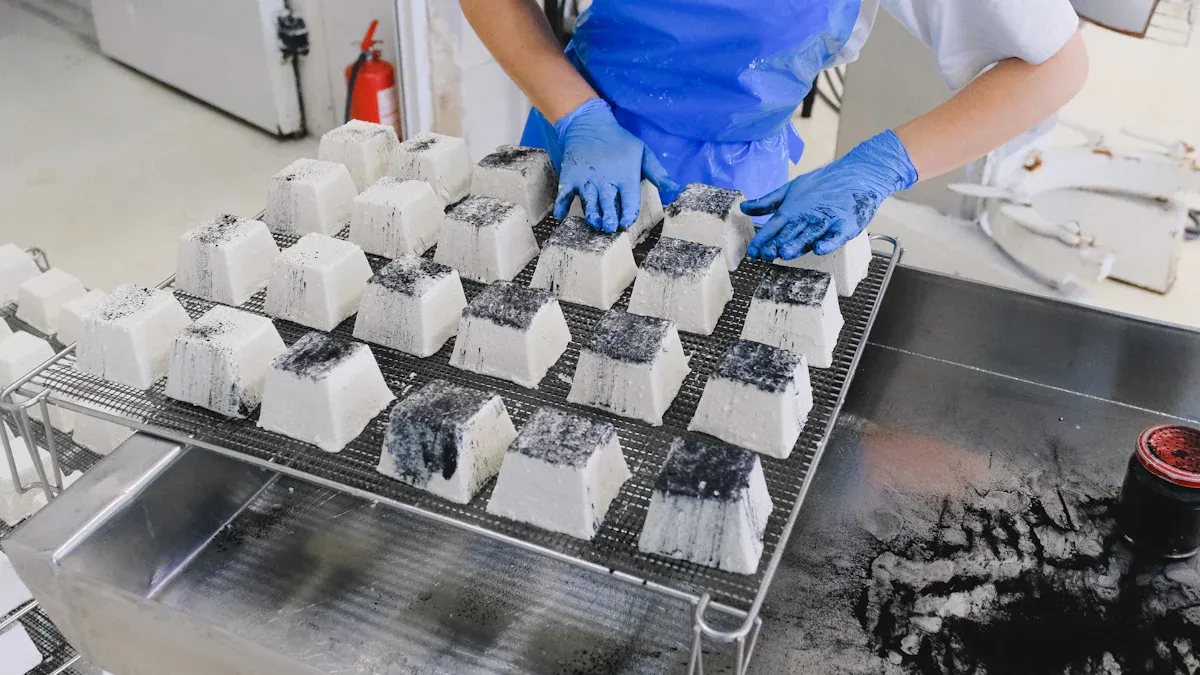
Choosing between small-batch and large-scale cosmetics manufacturing can significantly impact your business. These approaches differ in production scale, flexibility, and customization. Small Batch Cosmetics prioritize exclusivity, while large-scale production focuses on efficiency and cost-effectiveness. Understanding these differences is essential to align your strategy with market needs and consumer preferences.
Consider these industry insights:
The global cosmetic manufacturing market is projected to reach US$ 878.88 10억 ~에 의해 2034, growing at a 6.4% cagr.
Social media drives consumer trends, demanding quick adaptation from manufacturers.
Sustainability and customization are top priorities, pushing brands to adopt eco-friendly practices and tailored solutions.
By understanding these factors, you can make informed decisions that align with your goals, whether you aim for niche markets or mass appeal.
Small-Batch Cosmetics Manufacturing

Defining Small Batch Cosmetics
Small-batch cosmetics refer to products manufactured in smaller quantities, often with a focus on quality, customization, and sustainability. This approach allows brands to produce items in limited quantities, ensuring freshness and reducing waste. Unlike large-scale production, small batch manufacturing emphasizes flexibility and control, enabling you to adapt quickly to market trends or consumer feedback. For niche cosmetics companies, this method provides an opportunity to test new formulations without committing to high volumes.
Definition Aspect | 설명 |
|---|---|
The lowest number of units that can be ordered at one time in the cosmetic industry. | |
사용자 정의 | Small-batch production allows for tailored products that meet specific consumer needs. |
Scalability | Enables brands to efficiently scale production while managing costs. |
지속 가능성 | Focus on reducing waste and environmental impact through smaller production runs. |
This production model is particularly appealing to indie beauty brands and niche cosmetics companies that prioritize limited availability and exclusivity. By manufacturing in smaller runs, you can maintain better quality control and ensure that your products align with your brand’s values.
Advantages of Small Batch Production
Small batch production offers several benefits, especially for brands aiming to stand out in a competitive market. Here are some key advantages:
Flexibility and Customization: You can create tailored products that meet specific consumer needs, allowing you to cater to unique preferences. This is especially valuable for niche cosmetics companies.
지속 가능성: Smaller production runs reduce waste and environmental impact, aligning with the growing demand for clean and eco-friendly beauty products.
Faster Time-to-Market: Small batch production enables quicker product launches, helping you stay ahead in a fast-paced industry.
비용 효율성: By avoiding the need for large-scale infrastructure, you can save on operational costs and reduce financial risks.
Market Responsiveness: You can adapt to trends and consumer feedback more effectively, ensuring your products remain relevant.
The rising popularity of indie beauty brands highlights the importance of these advantages. Many of these brands rely on small batch production to deliver unique, high-quality offerings that resonate with their target audience.
Challenges of Small Batch Production
While small batch production has its benefits, it also comes with challenges that you need to consider:
Scalability Issues: Scaling up production while maintaining quality and consistency can be difficult. This requires careful planning and investment in resources.
Higher Costs per Unit: Producing in smaller quantities often leads to higher costs per unit, which can impact your pricing strategy.
규제 준수: Maintaining detailed batch records and meeting industry standards can be resource-intensive, especially for smaller teams.
Limited Availability: While exclusivity can be a selling point, it may also limit your ability to meet growing demand.
In the direct-to-consumer market, balancing growth with reliability is crucial. You must ensure that your products meet high standards while managing costs effectively. This is particularly important when scaling operations, as even minor inconsistencies can affect your brand’s reputation.
Ideal Scenarios for Small Batch Cosmetics
Small batch production works best in specific situations where flexibility, 품질, and customization matter most. Understanding these scenarios can help you decide if this approach aligns with your business goals.
1. Launching a New Brand or Product Line
If you’re starting a new cosmetics brand or testing a fresh product line, small batch manufacturing offers a low-risk solution. Producing in smaller quantities allows you to gauge market interest without committing to large volumes. This approach also helps you refine your formulations based on early customer feedback. 예를 들어, if you’re introducing a unique skincare serum, small batch production lets you test its appeal before scaling up.
2. Catering to Niche Markets
Small batch manufacturing is ideal for brands targeting niche audiences. These markets often demand specialized products that meet specific needs, such as vegan, 본질적인, or hypoallergenic cosmetics. By producing in smaller quantities, you can focus on creating high-quality items tailored to these preferences. This strategy not only builds trust but also strengthens your brand’s reputation for exclusivity.
3. Prioritizing Sustainability
If sustainability is a core value for your brand, small batch production aligns perfectly. Smaller runs reduce waste and minimize the environmental impact of overproduction. This approach also allows you to experiment with eco-friendly packaging and ingredients. Many consumers today prioritize brands that demonstrate a commitment to sustainability, making this a smart choice for environmentally conscious businesses.
4. Responding to Seasonal or Trend-Driven Demand
Trends in the beauty industry change rapidly. Small batch production enables you to respond quickly to these shifts. 예를 들어, if a particular ingredient or color becomes popular, you can create limited-edition products to capitalize on the trend. 비슷하게, seasonal items like holiday-themed cosmetics benefit from small batch runs, ensuring you don’t overproduce items with a short shelf life.
5. Maintaining Exclusivity
Exclusivity can be a powerful marketing tool. Small batch production helps you create limited-edition products that feel special to your customers. This strategy works well for luxury or boutique brands aiming to offer something unique. Limited availability often drives demand, making your products more desirable.
팁: Small batch production is not just about quantity; it’s about quality and adaptability. Use this approach to create products that resonate with your audience while staying true to your brand values.
By focusing on these scenarios, you can leverage small batch manufacturing to meet your business objectives effectively. Whether you’re launching a new product, targeting a niche market, or emphasizing sustainability, this approach offers the flexibility and control you need to succeed.
Large-Scale Cosmetics Manufacturing

Defining Large-Scale Manufacturing
Large-scale manufacturing refers to the process of producing cosmetics in high volumes using advanced machinery and streamlined operations. This approach focuses on efficiency, 일관성, and cost reduction. It allows brands to meet the demands of a broad consumer base by creating large quantities of products in a short time. Unlike small-batch production, mass production emphasizes uniformity, ensuring that every unit meets the same quality standards.
This method often involves automated systems and standardized processes. These systems help reduce human error and improve production speed. 예를 들어, a single production line can produce thousands of lipsticks or skincare products daily. Large-scale manufacturing is ideal for brands aiming to distribute their cosmetics globally or cater to mass-market retailers.
Benefits of Large-Scale Production
Mass production offers several advantages that make it a preferred choice for many cosmetics brands. Here are some key benefits:
비용 효율성
Producing cosmetics in bulk significantly lowers the cost per unit. This allows you to offer competitive pricing while maintaining profitability. Bulk purchasing of raw materials and packaging also reduces expenses.Consistency and Quality Control
Automated processes ensure that every product meets the same quality standards. This consistency builds trust among consumers, as they know what to expect from your brand.High Output Capacity
Large-scale manufacturing enables you to produce vast quantities of cosmetics quickly. This is essential for meeting the demands of large retailers or global markets.Scalability
당신의 브랜드가 성장함에 따라, mass production allows you to scale operations without major disruptions. You can increase output to match rising demand without compromising efficiency.글로벌 도달 범위
With the ability to produce in bulk, you can distribute your products to international markets. This expands your brand’s presence and increases revenue opportunities.
팁: If your goal is to dominate the mass market, large-scale manufacturing provides the tools to achieve it. Focus on streamlining your operations to maximize efficiency and output.
Drawbacks of Large-Scale Production
While mass production offers many benefits, it also comes with challenges that you need to address. These challenges often stem from the complexity of managing large-scale operations.
도전 | 설명 |
|---|---|
Stricter safety standards and regulations require advanced testing technologies and reformulation of products, increasing operational complexity and costs. | |
Economic Factors | Tariffs and economic instability disrupt supply chains and increase costs, forcing brands to reevaluate sourcing strategies, which adds complexity to operations. |
지속 가능성 및 환경 영향 | Transitioning to sustainable practices involves significant R&D investments and supply chain challenges, complicating operational processes. |
Technological Integration | Implementing advanced technologies like AI and blockchain requires substantial investment and poses logistical challenges, particularly for smaller companies. |
Health Concerns and Ingredient Transparency | Reformulating products to eliminate controversial ingredients necessitates extensive testing and regulatory approval, complicating operational workflows and increasing the need for transparency in labeling practices. |
Managing these challenges requires careful planning and investment. 예를 들어, adopting sustainable practices may involve redesigning your supply chain and investing in eco-friendly materials. 비슷하게, complying with international regulations demands thorough testing and documentation. These factors can increase costs and slow down production timelines.
메모: Addressing these drawbacks effectively can turn challenges into opportunities. Focus on innovation and adaptability to overcome operational complexities.
Best Use Cases for Large-Scale Manufacturing
Large-scale manufacturing works best when your business needs to produce high volumes of cosmetics efficiently and consistently. This approach supports brands aiming to meet widespread demand while maintaining competitive pricing. Below are some scenarios where large-scale production proves most effective:
1. Meeting High Consumer Demand
If your brand caters to a mass-market audience, large-scale manufacturing ensures you can meet the demand without delays. 예를 들어, global beauty brands often rely on this method to produce popular items like foundations or lipsticks in bulk. This allows you to stock shelves consistently and avoid product shortages, which can harm customer trust.
2. Expanding into Global Markets
When you plan to distribute your products internationally, large-scale production becomes essential. It enables you to produce enough inventory to supply multiple regions while maintaining uniform quality. 예를 들어, a major cosmetics company launching a new skincare line across Europe and Asia would benefit from the efficiency of mass production. This ensures every product meets the same standards, regardless of where it’s sold.
3. Reducing Costs for Competitive Pricing
Producing in bulk lowers the cost per unit, allowing you to price your products competitively. This is especially important if you’re targeting budget-conscious consumers or competing with established brands. By optimizing your production process, you can maintain profitability while offering affordable options.
4. Supporting Seasonal Promotions
Large-scale manufacturing is ideal for creating seasonal or promotional items. 예를 들어, holiday-themed gift sets or limited-edition collections require high-volume production to meet short-term demand. This approach ensures you can capitalize on seasonal trends without running out of stock.
5. Maintaining Consistency Across Product Lines
Consistency is crucial when building a trusted brand. Large-scale manufacturing uses automated processes to ensure every product meets the same quality standards. This is particularly important for items like foundations, where even slight variations in color or texture can disappoint customers. By maintaining uniformity, you strengthen your brand’s reputation for reliability.
6. Scaling Operations for Growth
As your business grows, large-scale production allows you to scale operations seamlessly. 예를 들어, if a product gains sudden popularity due to a viral social media trend, you can quickly increase output to meet the surge in demand. This scalability ensures you don’t miss out on opportunities to grow your market share.
Case in Point: A North American electronics manufacturer experienced a 35% spike in production volumes due to rising demand for smart devices. Although they faced challenges with efficiency, their ability to scale operations quickly helped them meet market needs. 비슷하게, in cosmetics, large-scale production ensures you can adapt to sudden increases in demand without compromising quality.
7. Supporting Retail Partnerships
If your brand partners with large retailers, you’ll need to meet their inventory requirements. Retail chains often require consistent stock levels to avoid empty shelves. Large-scale manufacturing ensures you can fulfill these demands while maintaining exclusivity for certain product lines. 예를 들어, you might reserve specific formulations or packaging designs for high-end retailers, creating a sense of exclusivity while still producing in bulk.
팁: While large-scale manufacturing focuses on efficiency, you can still incorporate elements of exclusivity by offering limited-edition products or unique packaging for specific markets.
By leveraging large-scale manufacturing, you can achieve efficiency, 일관성, 그리고 확장 성. This approach supports your growth while ensuring your products remain accessible to a broad audience.
Comparing Small Batch and Large-Scale Manufacturing
Cost Implications
Cost plays a significant role when choosing between small-batch and large-scale manufacturing. Small-batch production often involves higher costs per unit. This happens because smaller runs do not benefit from bulk discounts on raw materials or packaging. You may also face increased labor costs since small-batch processes often require more manual work. These factors can make small-batch products more expensive for consumers.
Large-scale manufacturing, 반면에, reduces costs by producing in bulk. Automated systems and economies of scale lower the cost per unit. This allows you to price products competitively, which is essential for mass-market appeal. 하지만, the initial investment in machinery and infrastructure can be substantial. If your business aims to grow rapidly, large-scale production offers a cost-effective solution in the long run.
Flexibility and Customization
Flexibility is a key advantage of small-batch production. You can quickly adapt to market trends or customer feedback. This approach allows you to create unique, customized products that cater to specific needs. 예를 들어, you can experiment with new formulations or limited-edition items without committing to large volumes. This makes small-batch production ideal for niche markets or seasonal demand.
Large-scale manufacturing, while efficient, offers less flexibility. The focus on uniformity and high output limits your ability to customize products. Adjusting formulations or packaging can disrupt production schedules. 하지만, if your goal is to maintain consistency across a global market, large-scale production ensures every product meets the same standards.
Quality Control and Consistency
Quality control is crucial in both small-batch and large-scale manufacturing. Small-batch production allows for meticulous oversight. You can monitor every step of the process to ensure high-quality results. This hands-on approach helps you maintain brand reputation, especially for luxury or boutique products.
Large-scale manufacturing relies on advanced systems to maintain consistency. Key quality control metrics include stable formulas, raw material testing, and in-process quality checks. Standard Operating Procedures (SOPs) document every step, ensuring uniformity. Stability testing at scale identifies potential issues before products reach the market. Batch testing and sample retention further verify quality. These measures build trust among consumers by delivering reliable products.
팁: Whether you choose small-batch or large-scale production, prioritize quality control to meet customer expectations and maintain brand loyalty.
Scalability and Growth Potential
Scalability plays a critical role in determining the long-term success of your cosmetics business. It reflects how easily your production can grow to meet increasing demand while maintaining quality and efficiency. Both small-batch and large-scale manufacturing offer unique opportunities and challenges when it comes to scaling operations.
Small-batch production provides flexibility, but scaling up can be resource-intensive. As demand grows, you may need to invest in additional equipment or hire more skilled workers to maintain quality. 예를 들어, a skincare producer improved process efficiency by 25% and enhanced product texture after adopting a horizontal bead mill. This type of innovation can help small-batch manufacturers scale without compromising quality. 하지만, the higher costs per unit and manual processes often limit how quickly you can expand.
Large-scale manufacturing, 반면에, is designed for growth. Automated systems and streamlined workflows allow you to increase output with minimal disruptions. A makeup brand reduced milling time by 30% and achieved finer color consistency, which led to a 20% drop in product returns. These advancements demonstrate how large-scale operations can handle higher volumes while maintaining uniformity. This approach is ideal if you aim to distribute products globally or partner with major retailers.
팁: To scale effectively, assess your current production capacity and identify areas for improvement. Whether you choose small-batch or large-scale manufacturing, adopting innovative technologies can enhance efficiency and support growth.
By understanding the scalability of each method, you can align your manufacturing strategy with your business goals. Small-batch production suits brands prioritizing exclusivity, while large-scale manufacturing supports rapid expansion and mass-market appeal.
Choosing the Right Manufacturing Approach
Assessing Business Goals
Your business goals serve as the foundation for selecting the right manufacturing approach. Start by identifying what you aim to achieve. Are you focused on launching innovative products, expanding into new markets, or maintaining consistent quality? Each goal requires a tailored strategy. 예를 들어, small-batch production works well for brands prioritizing product development and customization. 반면에, large-scale manufacturing supports goals like global distribution and cost efficiency.
To guide your decision, consider key areas such as product design, technology, material sourcing, and quality control. Regularly review these metrics to ensure they align with your objectives. Using SMART goals—specific, measurable, achievable, relevant, and time-phased—can help you define clear criteria for success. 예를 들어, if your goal is to reduce production costs by 15% within a year, large-scale manufacturing may be the better option.
팁: Flexibility in your metrics allows you to adapt to market changes and refine your strategy over time.
Evaluating Market Demand
Understanding market demand is crucial for choosing between small-batch and large-scale production. Analyze consumer preferences, trends, and the competitive landscape. 예를 들어, the growing popularity of natural cosmetics, 도달 할 것으로 예상됩니다 $54.5 10 억으로 2027, highlights a shift toward safer, non-toxic products. If your target audience values sustainability, small-batch production may align better with their expectations.
Statistical insights can also guide your decision. Chemical-based products, which dominate the market with a 63.5% share, appeal to consumers seeking visible results. If your brand focuses on scientifically backed ingredients like AHAs or BHAs, large-scale manufacturing can help you meet widespread demand. 또한, seasonal trends or niche markets may require smaller, flexible production runs to stay competitive.
메모: Market analysis not only reveals consumer preferences but also uncovers opportunities for innovation and growth.
Considering Budget and Resources
Your budget and available resources play a significant role in determining the best manufacturing approach. A well-planned budget helps you allocate resources effectively, ensuring smooth operations without waste. 예를 들어, small-batch production often requires less upfront investment, making it ideal for startups or brands with limited capital. 하지만, higher costs per unit may impact your pricing strategy.
Large-scale manufacturing demands significant investment in machinery and infrastructure but offers long-term cost savings through economies of scale. Detailed cash flow plans can help you manage obligations during slow periods and prepare for unexpected risks. By setting financial priorities, you can create a roadmap that aligns with your strategic objectives.
팁: Use multiple budgets to organize your finances and model potential risks. This approach ensures you can adapt to changing circumstances while maintaining operational efficiency.
Leveraging Expertise from Manufacturers like Oully
Partnering with an experienced manufacturer like Oully can transform your cosmetics business. Their expertise in private label and contract manufacturing helps you bring your vision to life while ensuring quality and efficiency. 10 년이 넘는 경험으로, Oully offers tailored solutions that align with your brand’s goals.
Olly를 선택하는 이유?
Oully specializes in creating customizable beauty products. 그들의 fda-, 이소의 뜻, and cGMP-certified facility ensures compliance with industry standards. You gain access to advanced technologies and sustainable practices that enhance your product offerings. Whether you need body care, facial care, 또는 남성 손질 제품, Oully provides end-to-end support.
Benefits of Collaboration
Working with Oully simplifies the manufacturing process. Here’s how they add value to your business:
Custom Formulation: Oully helps you develop unique products that reflect your brand identity. Their team works closely with you to ensure personalization in every detail.
빠른 처리 시간: With a production timeline of just 34 날, you can launch products quickly and stay ahead of trends.
Low MOQ Options: Small-batch production becomes accessible, allowing you to test new ideas without committing to large volumes.
Dropshipping Services: Oully handles logistics, enabling you to focus on marketing and customer engagement.
팁: Use Oully’s expertise to streamline operations and reduce costs. Their innovative solutions help you scale your business while maintaining quality.
How Oully Supports Growth
Oully’s scalable manufacturing capabilities make them ideal for growing brands. Their global reach ensures your products meet international standards. By leveraging their resources, you can expand into new markets confidently. Their commitment to sustainability also aligns with consumer demand for eco-friendly products.
Collaborating with Oully empowers you to focus on creativity and strategy. Their personalized approach ensures your products stand out in a competitive market.
Understanding the differences between small-batch and large-scale manufacturing helps you make informed decisions. Small-batch production offers flexibility and customization, while large-scale manufacturing ensures efficiency and scalability. Each approach serves distinct business goals.
팁: Align your manufacturing strategy with your objectives. If you prioritize exclusivity or sustainability, small-batch production fits your needs. For mass-market appeal or global expansion, large-scale manufacturing provides the tools to grow.
Evaluate your market demand, budget, and resources carefully. Choose the method that supports your vision and ensures long-term success.
FAQ
1. What is the main difference between small-batch and large-scale manufacturing?
Small-batch manufacturing focuses on flexibility and customization, while large-scale production emphasizes efficiency and consistency. Small-batch suits niche markets or limited editions. Large-scale works best for mass-market products and global distribution.
팁: Choose based on your business goals and target audience.
2. Can small-batch production help reduce waste?
예, small-batch production minimizes waste by producing only what you need. This approach aligns with sustainable practices and reduces environmental impact. It’s ideal for brands prioritizing eco-friendly values.
♻️ Sustainability Alert: Small-batch production supports green initiatives by avoiding overproduction.
3. Is large-scale manufacturing suitable for startups?
Large-scale manufacturing may not suit startups due to high initial costs. Small-batch production offers a more affordable option for testing products and building your brand.
메모: Start small, then scale up as your business grows.
4. How do I decide between the two approaches?
Evaluate your goals, budget, and market demand. Small-batch works for exclusivity and innovation. Large-scale suits high-volume needs and cost efficiency.
팁: Partner with experts like Oully to find the best fit for your brand.
5. Can I combine both methods?
예, many brands use both methods. Small-batch production helps test new ideas, while large-scale manufacturing supports established products.
예: Launch a limited-edition product in small batches, then scale up if demand grows.
















